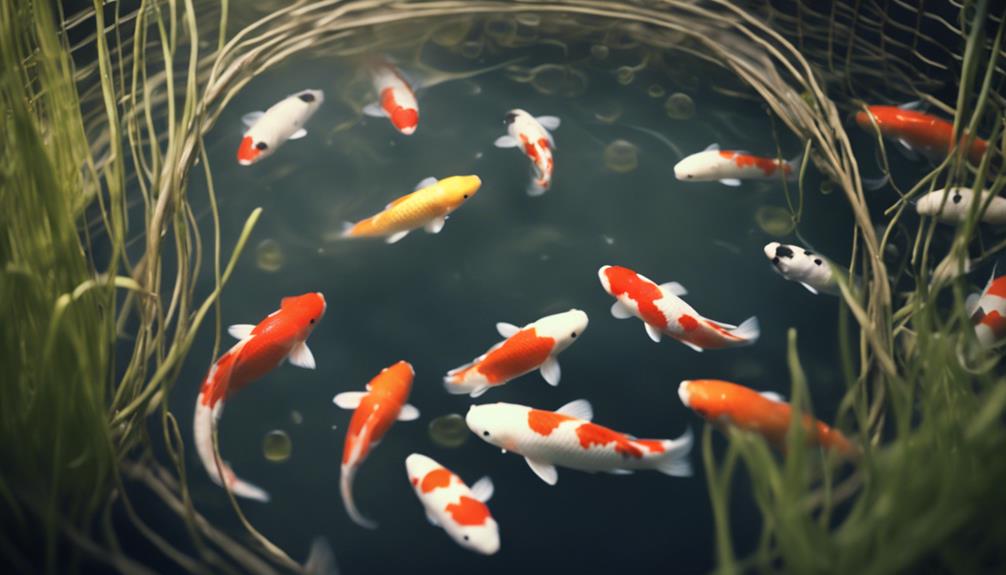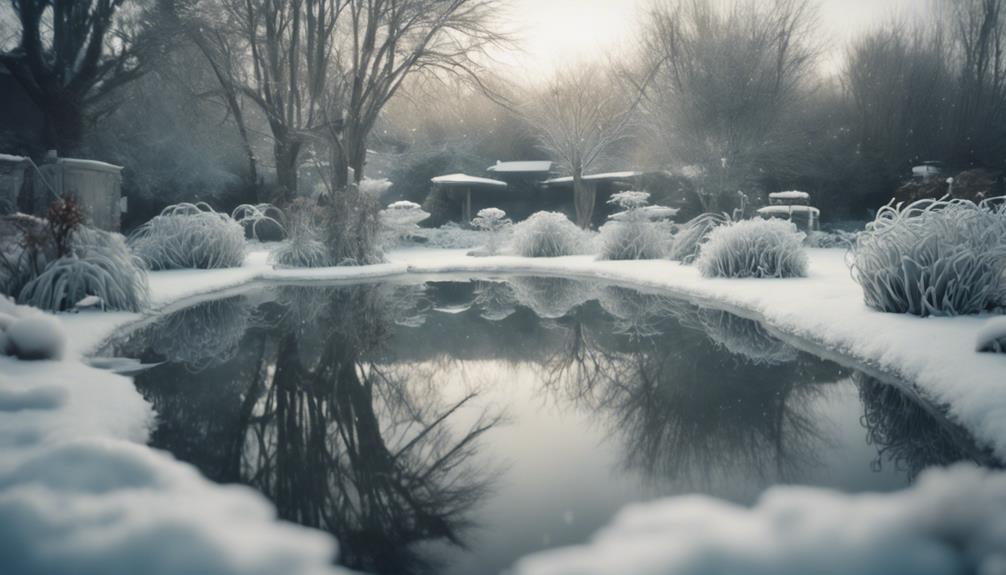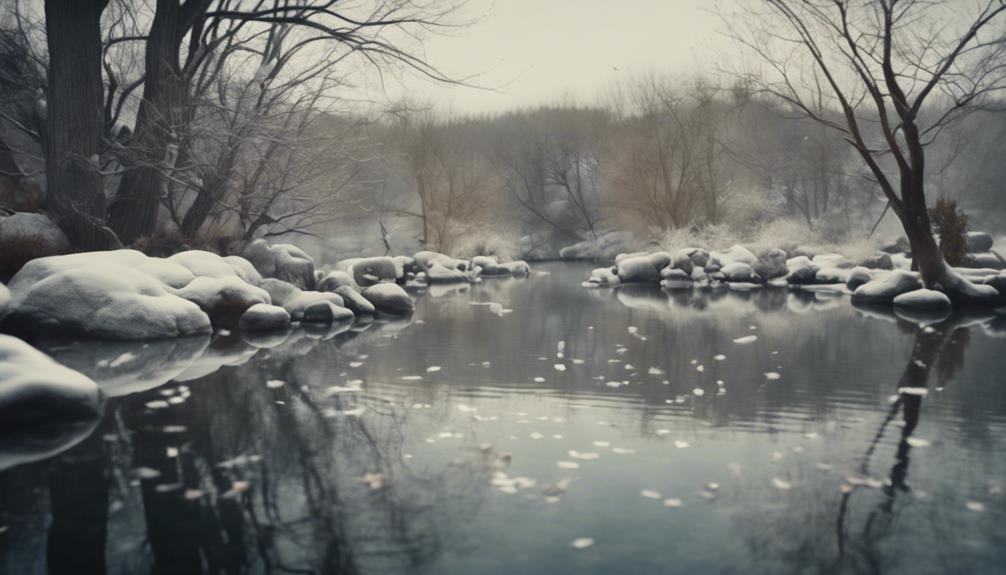When breeding koi in cold climates, you'll need to create a carefully controlled environment that mirrors the fish's natural habitats, complete with shallow water, abundant vegetation, and protection from harsh winds and extreme temperatures. Certify gentle aeration for peak water quality and circulation, and maintain a water temperature between 65-75°F (18-24°C) for ideal breeding conditions. You'll also need to create a separate spawning pool to prevent eggs from being eaten, and set up a shallow water area for natural spawning. By following these essential tips, you'll be well on your way to successfully breeding koi in cold climates – and that's just the beginning of your journey.
Table of Contents
Key Takeaways
- Maintain a controlled environment with a water temperature between 65-75°F (18-24°C) for ideal breeding conditions in cold climates.
- Ensure gentle aeration for peak water quality and circulation to mitigate the risks associated with cold water.
- Monitor koi eggs and fry closely for signs of illness, such as wounds and infection, which can be more prevalent in cold climates.
- Use a non-metallic breeding set to mitigate swim bladder problems that can be exacerbated by cold water.
- Provide ideal conditions, including a nutrient-rich diet and frequent water changes, to support rapid growth and development in cold climates.
Preparing the Breeding Environment
To guarantee successful koi breeding in cold climates, you'll need to set up a controlled environment that mirrors the ideal conditions found in their natural habitats, which typically feature shallow water, abundant vegetation, and protection from harsh winds and extreme temperatures.
This breeding environment should be gently aerated to maintain peak water quality and circulation. You'll want to create a shallow water area, around 12-18 inches deep, where males and females can spawn naturally.
Make sure the water temperature is between 65-75°F (18-24°C), as this is ideal for koi breeding. A separate spawning pool is recommended to prevent the eggs from being eaten by other fish.
By creating this controlled environment, you'll be making sure your koi have the best chance to spawn naturally and produce fertilised eggs. Remember, attention to detail is vital in creating a prime breeding environment, so take the time to get it right.
With the right setup, you'll be well on your way to successfully breeding koi in cold climates.
Understanding Koi Mating and Spawning
With your breeding environment set up, you're now ready to focus on the intricacies of koi mating and spawning, a complex process that requires careful observation and understanding to guarantee successful breeding.
As you prepare for the breeding season, it is vitally important to understand the nuances of koi mating and spawning to make certain a successful fertilization process.
Timing is everything: Koi mating typically occurs in the late afternoon, with the male koi courting the female for several hours before spawning just before dawn.
Pheromones play a pivotal role: During spawning, the female koi releases a pheromone that attracts the male, guiding him to the spawning location, where he'll fertilize her eggs.
Separate spawning is key: After spawning, the parents should be removed from the breeding tank to prevent them from eating the eggs, and the eggs should be monitored for signs of fertilization and development.
Caring for Young Koi and Eggs

You now face the vital task of caring for the young koi and eggs, where meticulous attention to detail can make all the difference between successful breeding and disastrous failure.
After successful egg fertilisation, vital monitoring of the koi eggs for development is necessary, removing any dead or white eggs to prevent fungal growth. Malachite green can be used to prevent fungal growth on the eggs.
Fresh water with slow changes is vital for healthy development, and you should guarantee water temperature control, as it has a profound impact on fry development speed. Warmer water speeds up development, while cooler water slows it down.
Once the fry have developed and are swimming freely, they'll take their first gulp of air around 7-8 days after spawning.
As you care for the koi fry, prioritize water changes to maintain superior water quality. By doing so, you'll set the stage for healthy development and increase the chances of successful breeding. Remember, attention to detail is key in this vital stage.
Feeding and Nourishing Koi Fry
As koi fry begin to develop mouths and venture to the surface for air, they require a nutrient-rich diet to support their rapid growth and development.
At this stage, you'll need to feed the fish a diet that caters to their high metabolisms.
Feed frequently: Feed your Koi 4-6 times a day, as they need a constant supply of nutrients to support their growth.
Start with the right food: Begin with a starter food such as a commercial koi fry meal or a homemade mixture of hard-boiled egg yolk and water.
Introduce live foods: Enrich their diet with live foods like brine shrimp or infusoria as soon as possible to promote ideal growth and health.
Managing Risks and Challenges

Raising koi fry in cold climates poses unique challenges that demand attention to detail and proactive management to guarantee the health and survival of your young fish.
You must create the right conditions for your fry to thrive. This includes meeting their specific water needs, which can be challenging in cold climates.
Females must be separated from males to prevent over-fertilisation, as fertilised eggs are greatly susceptible to damage in cold temperatures.
You'll also need to monitor your fry for signs of illness, such as wounds and infection, which can be fatal if left untreated.
A common issue in cold climates is swim bladder problems, where the fish struggles to maintain its buoyancy.
To mitigate this, use a non-metallic breeding set that consists of a spawning tank, a hatching tray, and a rearing tank.
By providing ideal conditions and monitoring your fry closely, you can reduce the risks associated with breeding koi in cold climates.
Remember, attention to detail is key to ensuring the health and survival of your young fish.
With the right care and management, you can successfully breed koi in even the chilliest of climates.
Frequently Asked Questions
Can You Breed Koi in Winter?
You can't breed koi in winter as they typically enter a state of dormancy, or hibernation, in cold climates, making fish reproduction nearly impossible in frosty temperatures and icy waters of frozen ponds during chilly weather.
How Do You Encourage Koi to Breed?
"Blood is thicker than water" rings true when creating a breeding haven for koi. You'll encourage breeding by ensuring koi maturity, optimizing water quality, and providing spawning triggers, nutritious food, and a well-designed pond with ample water movement, spawning sites, and habitat optimization.
What Are the Conditions for Koi Breeding?
You guarantee ideal koi breeding conditions by maintaining impeccable water quality, controlling temperature between 17-26°C, and designing a shallow pond (10-12 inches deep) with gentle filtration, aquatic plants, and spawn triggers, while selecting healthy parents and protecting eggs.
Will Koi Eggs Hatch in Cold Water?
You carefully consider the cold water conundrum, knowing that koi eggs won't hatch below 17°C (63°F), as fertilization rates and egg quality suffer, compromising incubation periods, egg development, and ultimately, hatching success.
Conclusion
By following these 5 essential tips, you'll be well on your way to successfully breeding koi in cold climates.
Just like the Smiths, who after implementing these strategies, harvested a batch of vibrant, disease-resistant koi from their Wisconsin backyard pond, you too can achieve similar results.
With attention to detail and a willingness to adapt, you can overcome the challenges of cold-weather koi breeding and enjoy the rewards of raising these stunning fish.

